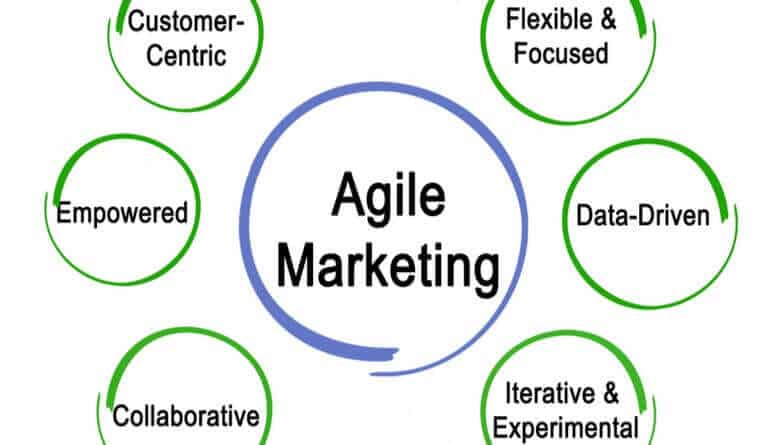Businesses use many strategies to help improve efficiency and effectiveness within their company. One tactical method is agile marketing, where teams identify issues and focus collective efforts on high-profile projects. To help you to make the right choice, we present this solid, data-driven collection of the benefits of agile marketing.
These projects are completed with a group effort and then these results are measured and used to improve future results with similar or bigger projects. The collective efforts are made to help complete large-scale projects faster so that more high-value projects are completed to help further the company.
It’s this measure of data and analytics that also helps determine the team’s value of certain projects.
Top 13 Benefits of Agile Marketing
When companies choose to implement Agile Marketing, this improved response and effort towards projects help teams navigate marketing trends and the amount of effort that is required for certain projects.
Once this information is analyzed and distributed accordingly, teams can determine just how much effort is required to complete a certain project. In addition, this can also possibly free other resources or assets to assign to another high profile project.
-
Productivity
Productivity is one of the biggest benefits of agile marketing. With the analysis of data and seeing how much effort it takes to complete a task/project, prioritizing workflows becomes easier. This ultimately increases productivity by allocating resources to the right place in order to reach maximum productivity.
-
Transparency
With Agile Marketing in place, there’s no hiding how much it takes for projects to be completed. With this in mind, transparency allows the entire company to see where resources are distributed, needed, and used on projects.
-
Effective Priority Management
By allocating assets to projects and seeing how much is needed for each one helps prioritize projects that may take longer or require more resources than others. Data taken from this strategy helps distribute the work to maximize high priority projects.
-
Measurability
When looking at data, it’s an opportunity for teams to look and measure results. This feature of being measured helps those working with the data know where to adjust different aspects in order to maximize the effectiveness of agile marketing.
( Also Read: What is Agile Marketing – A Complete Guide )
-
Adapt to Change
Once issues are identified, this helps highlight areas that need change and help in order to succeed. This can lead to teams becoming more flexible and agile as they work towards the same goal.
-
Customer Satisfaction
As companies and their workers strive for better ways to improve their workflow, this will translate to higher customer satisfaction. When companies are working towards becoming better, this will lead to increased product quality, faster turnarounds on projects, and higher customer satisfaction as the company improves.
-
Competitiveness
This can be related to competitiveness within teams to become better and faster, as well as competitiveness in the companies industry. As other companies seek to become better, this drives the competitive edge for other companies to also improve so that they do not become outdated. This helps elevate industries as a whole to create high-quality products.
-
Improved Internal Communication
As teams work closer together on high-value projects, communication becomes even more important as workers need to be able to talk and work efficiently together. With more transparency, information to work with, and increased quality asset allocation, agile marketing provides a better way for employees to communicate in their workspace.
-
Greater Planning & Flexibility
Teams can benefit from planning and flexibility for projects. By using data and analytics to see how many resources it takes to complete a project, this can help prioritize certain projects and distribute more work amongst teams to finish high value and priority projects faster while still giving enough time to smaller value projects and completing them in a reasonable amount of time.
-
Efficient & Continuous Improvement
As efficiency is increased for high-quality projects, this leads to growth within teams and other projects, ultimately improving them and making them better. As they get better, this can lead to newer high-quality projects as well as more valuable information to improve upon in other aspects of the business.
-
Increased ROI
When distributing resources and assets to projects efficiently, this will ultimately make them worth their effort since they are used to their maximum efficiency. This increased their return on investment as there are not negative losses when using these resources and dedicating time to new projects.
-
Scale for Growth
As projects are completed and assets are properly distributed, this allows businesses to grow. New projects will come from success and completed projects can be done again quickly and with more efficiency if necessary. This scaling allows for businesses to grow, employees to get better and for the industry as a whole to improve.
Agile Marketing Challenges
During times of crisis or when major issues arise, marketers are forced to move away from their original strategies, which could include agile marketing(1).
As these come up, companies must be flexible enough to work through this and allocate enough resources and assets through agile marketing to still be efficient. A business can still use agile marketing during these difficult times, however, it’s important to keep its fundamental work intact in order to maximize productivity. Without careful planning, with or without a crisis, agile marketing can easily fail.
Final Thoughts
There are many strategies to get businesses to work at an efficient level, and agile marketing is a quick and analytical strategy to help businesses reach that point. By picking certain values to implement into completing tasks and projects, using typical agile practices, and understanding all that agile marketing brings to the table, workers can develop a system that truly benefits their business.
***
Miguel Pobre is a freelance content creator based in Portland, OR. He graduated from the University of Oregon with a Bachelor of Arts Degree in Journalism and a minor in Business Administration. Alongside writing, Miguel has a passion for photography and design. Connect with him on LinkedIn.





